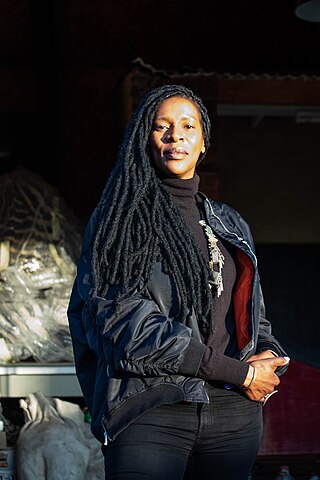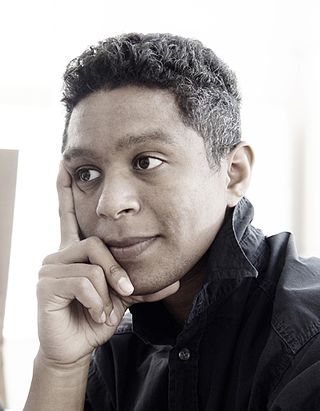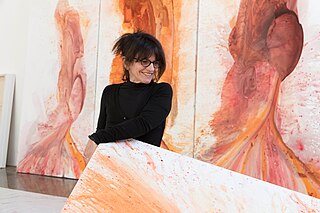Carla Liesching | |
|---|---|
| Born | 1985 (age 38–39) |
| Education | Rhodes University |
| Known for | Photography |
| Website | carlaliesching |
Carla Liesching (born 1985) is a South African artist based in Ithaca, New York. [1]
Carla Liesching was born in Cape Town in 1985 and was raised in various small towns around SA, mainly in the Eastern Cape. She received her BFA, specialising in photography, video and sound installation, from Rhodes University in Grahamstown and moved to Johannesburg shortly after graduating in 2007. [2]
She has spent time working in Taipei, Taiwan and is currently based in New York City. [3]
Her work investigates human relationships to structure, particularly ideological shifts in geographic organisation and narrative. Liesching's practice addresses conceptions of self in relation to place, movement, distance and belonging. Interested in the photographic portrait's agency in the shaping of identity narratives, Liesching creates archives of staged environmental portraits, which parodically hearken back to the medium's early involvement with human classification systems and pseudo-scientific exploration (for example, photography used in the aid of physiognomy, physical anthropology, phrenology, Darwinism and colonialism.) [4] Liesching's installations often include sculptural and sound components alongside her photographic work. [5]
Liesching is represented by Cape Town-based gallery Brundyn & Gonsalves. [1]
Her series The Swimmers, [6] shows people "in countries and cultures from all over the world, dressed in nothing but their bathing suits. Only the backgrounds are neither beaches, nor oceans [...] Instead, Liesching sets her subjects against abandoned factories, motionless waters, fields of grain and rough urban landscapes. [...] because they've grown up in a world that has changed too quickly and is losing all of its points of reference along the way [...] It's a way of underlining their desire to belong, their need for identity, while they live -- naked -- before the whole world." [7]
Good Hope (2021) "critically examines South Africa's colonial past". The book is made up of both photographs and personal prose. The photographs—clippings of images from tourist pamphlets, old magazines, current newspapers and family albums—focus on the gardens and grounds of the Cape of Good Hope. The work is about colonialism, tourism and trade. [8]
David Goldblatt HonFRPS was a South African photographer noted for his portrayal of South Africa during the period of apartheid. After apartheid had ended he concentrated more on the country's landscapes. What differentiates Goldblatt's body of work from those of other anti-apartheid artists is that he photographed issues that went beyond the violent events of apartheid and reflected the conditions that led up to them. His forms of protest have a subtlety that traditional documentary photographs may lack: "[M]y dispassion was an attitude in which I tried to avoid easy judgments. . . . This resulted in a photography that appeared to be disengaged and apolitical, but which was in fact the opposite." He has numerous publications to his name.
Berni Searle is an artist who works with photography, video, and film to produce lens-based installations that stage narratives connected to history, identity, memory, and place. Often politically and socially engaged, her work also draws on universal emotions associated with vulnerability, loss and beauty.
Candice Breitz is a South African white artist who works primarily in video and photography. She won a 2007 Prince Pierre de Monaco Prize. Her work is often characterized by multi-channel moving image installations, with a focus on the “attention economy” of contemporary media and culture, often represented in the parallelism of the identification with fictional characters and celebrity figures and widespread indifference to global issues. In 2017, she was selected to represent South Africa at the 57th Venice Biennale.
Zanele Muholi is a South African artist and visual activist working in photography, video, and installation. Muholi's work focuses on race, gender and sexuality with a body of work that dates back to the early 2000s, documenting and celebrating the lives of South Africa's Black lesbian, gay, transgender, and intersex communities. Muholi is non-binary and uses they/them pronouns, explaining that "I'm just human".

Nandipha Mntambo is a South African artist who has become famous for her sculptures, videos and photographs that focus on human female body and identity by using natural, organic materials. Her art style has been self described as eclectic and androgynous. She is best known for her cowhide sculptures that connects the human form to nature.
Tom Cullberg is an artist born in Stockholm, Sweden, in 1972. He currently lives and works in Cape Town, South Africa.
Sanell Aggenbach is a South African artist living and working in Woodstock, Cape Town. Using painting, printmaking, and sculpture, her work addresses the relationship between history and private narratives, with a sense of ambiguity. Her work also explores the processes of nostalgia and historical myth-making, often incorporating the playful, disarming, and absurd to draw the viewer into discussions of darker subjects. She has a unique style of combining traditional painting techniques with sculptural elements, as well as typically feminine crafts such as sewing and tapestry.

Ashley Walters is a South African-born and based artist who works with photography and film.
George Hallett was a South African photographer known for images of South African exiles. His body of work captures much of the country's turbulent history through Apartheid and into the young democracy.
Cedric Nunn is a South African photographer best known for his photography depicting the country before and after the end of apartheid.
Nontsikelelo "Lolo" Veleko is a South African photographer most noted for her depiction of black identity, urbanisation and fashion in post-apartheid South Africa.

Sue Williamson is an artist and writer based in Cape Town, South Africa.
Mary Sibande is a South African artist based in Johannesburg. Her art consists of sculptures, paintings, photography, and design. Sibande uses these mediums and techniques to help depict the human form and explore the construction of identity in a postcolonial South African context. In addition, Sibande focuses on using her work to show her personal experiences through Apartheid. Her art also attempts to critique stereotypical depictions of women, particularly black women.
Jane Alexander is one of the most celebrated artists in South Africa. She is a female artist best known for her sculpture, The Butcher Boys. She works in sculpture, photomontages, photography and video. Alexander is interested in human behavior, conflicts in history, cultural memories of abuse and the lack of global interference during apartheid. Alexander's work is relevant both in the current Post- Apartheid social environment in South Africa and abroad.

Penny Siopis is a South African artist from Cape Town. She was born in Vryburg in the North West province from Greek parents who had moved after inheriting a bakery from Siopis maternal grandfather. Siopis studied Fine Arts at Rhodes University in Makhanda, completing her master's degree in 1976, after which she pursued postgraduate studies at Portsmouth Polytechnic in the United Kingdom. She taught Fine Arts at the Technikon Natal in Durban from 1980 to 1983. In 1984 she took up a lectureship at the University of the Witwatersrand in Johannesburg. During this time she was also visiting research fellow at the University of Leeds (1992–93) and visiting professor in fine arts at Umeå University in Sweden (2000) as part of an interinstitutional exchange. With an honorary doctorate from Rhodes University, Makhanda – Siopis is currently honorary professor at Michaelis School of Fine Art, University of Cape Town.
iQhiya is a network of young black women artists based in Cape Town and Johannesburg, South Africa. They specialise in a broad range of artistic disciplines including performance art, video, photography, sculpture and other mediums.
Roshini Kempadoo is a British photographer, media artist, and academic. For more than 20 years she has been a lecturer and researcher in photography, digital media production, and cultural studies in a variety of educational institutions, and is currently a professor in Photography and Visual Culture at the University of Westminster.

Jo Ractliffe is a South African photographer and teacher working in both Cape Town, where she was born, and Johannesburg, South Africa. She is considered among the most influential South African "social photographers."
Phumzile Khanyile is a South African photographer, living in Johannesburg. Her series Plastic Crowns is about women's lives and sexual politics. The series has been shown in group exhibitions at the Palace of the Dukes of Cadaval in Evora, Portugal; Iziko South African National Gallery in Cape Town; and the National Gallery of Victoria in Melbourne, Australia; and was a winner of the CAP Prize for Contemporary African Photography,
Thania Petersen is a multi-disciplinary artist. Her work is in the collections of notable museums and galleries including the Smithsonian's National Museum of African Art and the Zeitz Museum of Contemporary Art Africa.